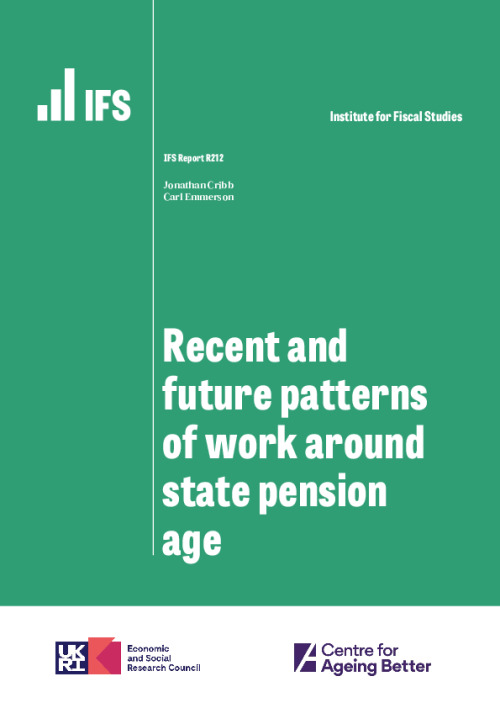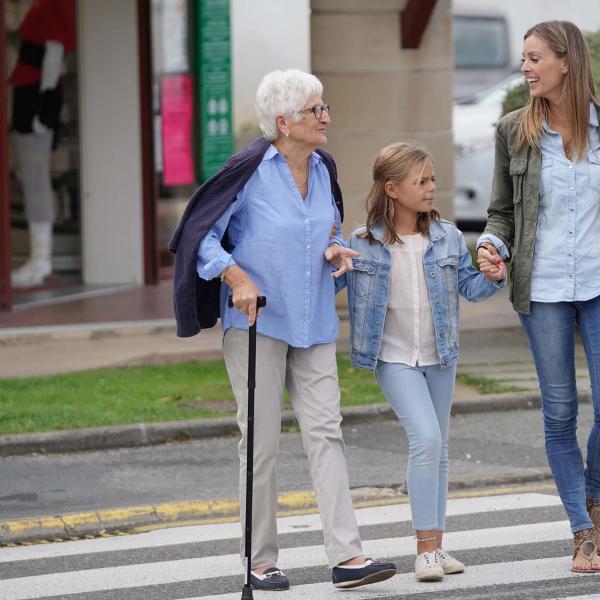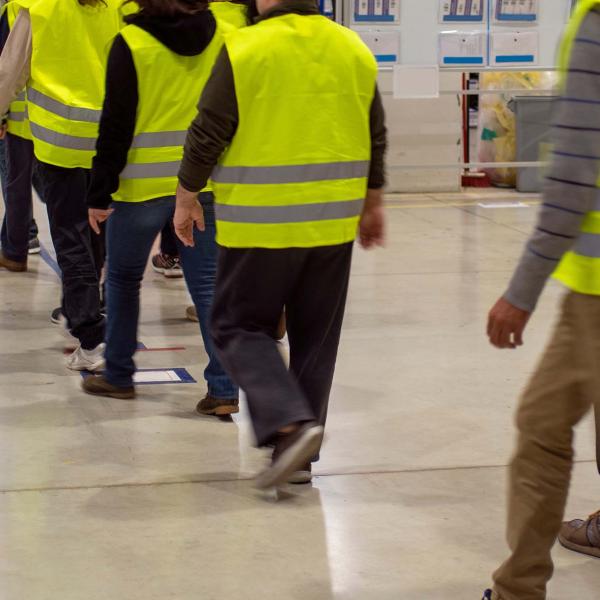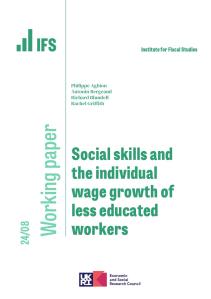There have been dramatic changes in the patterns of work among people in their 50s and 60s over the last 50 years. The gradual increases in employment since the mid-1990s are generally welcome. A longer working life boosts household incomes, as people are reliant on their wages and salaries for longer (as opposed to state benefits), they have longer to accumulate private pension wealth, and fewer years in retirement to draw upon their private pension resources. There have been changes not only in the number of people in work, but also in the types of work they have been undertaking, with particularly large rises in full-time work for women.
Increases in employment – particularly for women in their early 60s – have also been driven by increases in the state pension age since 2010. Rises in the state pension age are a coherent response to the public finance challenge of increased longevity, and they have increased employment significantly. But a higher state pension age also exposes more individuals to the much less generous working-age benefit system for longer; state support for those not in paid work is much more generous for those just above the state pension age than for those just below it, and this gap has increased substantially over the last 20 years. A higher state pension age is particularly challenging for those who would like to be in paid work, but cannot work due to poor health or being unable to find a suitable job.
In contrast to the long-running trends of higher employment and falling economic inactivity, the labour market for older workers has seen a sharp turnaround since the pandemic, with lower rates of employment driven not by much higher unemployment (people unable to find work) but by economic inactivity (people out of work who are not searching for work, for various reasons). Since the beginning of the pandemic, long-standing increases in self-employment have reversed, including amongst older workers among whom self-employment is relatively more common.
This report brings together new evidence on these issues to examine the recent trends in, and prospects for, the labour market for people in their 50s and 60s. We draw upon evidence from a two-year programme of work conducted in partnership between the Institute for Fiscal Studies and the Centre for Ageing Better whose key aim has been to understand better the changing patterns of work for older workers. But we also bring new evidence from analysis of recent microdata on labour market outcomes and expectations to help provide an assessment of the situation facing older workers in coming years.
Key findings
- The patterns of employment among people in their 50s and 60s are dramatically different to those seen a few decades ago. The biggest change has been the increase in employment rates among women aged 60–65. Employment rates in that age group are now around 25 percentage points higher than in 1995, in part driven by the increases in the state pension age since 2010. For men, the striking fact is how gradually men’s employment rates now decline at older ages compared with the mid-1970s. In 1975, over half of men left paid work between the ages of 62 and 66, whereas now just three in ten men leave paid work over the same ages.
- Between 2011 and the pandemic, economy-wide employment rates consistently – and often substantially – outperformed official government forecasts. However, since the pandemic, employment has fallen and economic inactivity has risen whereas, before the pandemic, employment had been forecast to continue rising and economic inactivity to continue falling. This is especially the case for those aged 50+. With a forecast of flat, or gradually declining, employment rates over the next five years, the official forecast implicitly assumes that these declines for older people will not be reversed in the next few years.
- There are reasons to think that employment rates among people aged 50–69 could rise in coming years. First, each successive generation approaches retirement with greater labour market attachment, work experience over their lives, and education than their predecessors. This is particularly true of women. We would expect these patterns in general to keep people in work for longer, pushing up employment rates. Second, the state pension age is rising from 66 to 67 between 2026 and 2028. Given the strong rises in employment for 65 year olds seen as a result of the recent increase in the state pension age from 65 to 66, it would be surprising if this did not act to push up employment further.
- Consistent with this, there have been large increases in expected retirement ages. The proportion of people aged 40–54 expecting to retire after the age of 65 increased sharply between 2006–08 and 2018–20, from 10% to 49% among men and from 6% to 45% among women. These increases were most dramatic between 2008 and 2014, but continued to rise more gradually between 2014 and 2019.
- Increased economic inactivity among people aged 50–69 has been driven by greater moves out of employment into retirement and other forms of economic inactivity since the pandemic started. The evidence does not suggest that this is primarily driven by individuals leaving their jobs due to poor health. In the second half of 2021, the number of workers aged 50–69 leaving employment for retirement or other inactivity was at least 20% higher than pre-pandemic, even as the labour market bounced back from the pandemic, and the risk of hospitalisation from COVID-19 had been substantially curtailed by the vaccination programme.
- It seems likely that full-time work will play an increasingly important role for workers aged 50–69 in the coming years. There has been a dramatic increase in the share of women working full-time in particular, doubling from 17% for women aged 50–69 in full-time work in 1992 to 34% in 2021.This is despite that fact that around a quarter of full-time workers in their early 60s say they want to work fewer hours. In contrast, rates of part-time work at these ages have fallen back since the pandemic, with higher fractions of part-time employees moving into economic inactivity. Similarly, since the pandemic, there have been falls in the proportion of people who are self-employed, both overall and among older individuals. Since the pandemic, older self-employed workers have also been more likely to leave paid work for economic inactivity than previously.
- Higher state pension ages encourage some people to delay retirement and continue to work at older ages, but most people do not work longer as a result. The increase in the state pension age from 65 to 66 caused the number of employed people aged 65 to increase by 55,000 in 2021. But it also meant that 5,000 more people aged 65 were unemployed (rather than retired) and 27,000 more 65 year olds who were out of work reported that it was because they were long-term sick or disabled (again, rather than being retired). There is an increasingly large gap between the generosity of state support provided once someone reaches the state pension age compared with what is available prior to this age. In other words, the increases in the state pension age lead to more out-of-work people relying on the comparatively less generous working-age benefit system for longer.
- Reductions in household income for people aged 65 resulting from the most recent increase in the state pension age have caused absolute income poverty amongst 65 year olds to more than double, rising by 13 percentage points. This is because most 65 year olds who are below the state pension age are not in paid work and do not have a partner who is in paid work. While some in this group have reasonable – or even substantial – private pensions, others do not. The increases in poverty at age 65 have been larger for groups that are generally closer to the poverty line: single people, people with fewer educational qualifications, and renters.












